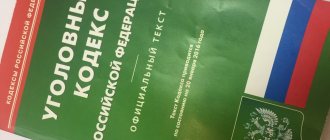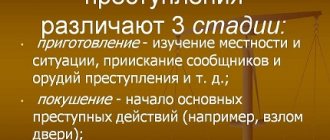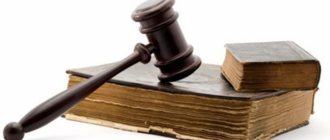The concept of qualification of crimes
Remark 1
Qualification of crimes is the process of establishing the signs of a criminal act in the actions (inactions) of a person, which is a set of mental actions subject to the laws of logical thinking to solve certain problems.
The process of qualifying a criminal act is the process of reflecting in the mind of the subject of qualification of criminal acts the signs of a specific crime, the actual signs of the crime provided for by criminal law, the presence (absence) of similarities between the actual signs and the signs of the crime.
The starting point and prerequisite for defining the concept of the process of qualifying a criminal act is the approval of its epistemological essence as a subjective category, representing a reflection in the consciousness of the subject of objectively existing factual (phenomena, acts, things, processes) and legal (international treaties, norms of law, regulations) realities, their relationships.
Are you an expert in this subject area? We invite you to become the author of the Directory Working Conditions
The process of qualifying a crime consists of determining the signs of a criminal act, which may correspond or correspond to the actual signs of the crime, in choosing a criminal law norm, and disclosing its content. In the process of qualification, the actual signs of the crime are detailed separately, each sign of the crime is specified, the signs are brought to the level of comparability, brought to a “common denominator”, in comparison, comparison of the signs of the crime with the signs of the crime.
Where should the result of the qualifying event be contained?
The qualification of a criminal act is carried out at the stage of preliminary investigation of an opened criminal case. In addition, it is one of the tasks of cassation and supervisory proceedings. The result of the process, corresponding to the Criminal Procedure Code, must be contained in the following criminal procedural acts:
- decision to initiate a criminal case or refusal to initiate it;
- a resolution to bring a citizen as an accused in the case under consideration;
- decision on the application of a preventive measure;
- closing indictment;
- guilty verdict.
The result of qualifying measures carried out for a criminal offense is recorded by accurately listing the names of all articles of the Criminal Code, according to which a person is subject to responsibility for his actions.
When qualifying a crime, it is necessary to indicate articles of both the General and Special Parts of the Criminal Code.
The classification of a crime is an important and responsible moment in the work of investigative bodies, which must be approached as responsibly as possible. It is worth noting that any criminal act can be reclassified if new circumstances are discovered during the investigation, for example, intentional murder can be reclassified as unintentional and vice versa.
Such a concept as the qualification of crimes, its foundations, principles, methods, types and stages, are the subject of debate in circles of legal theorists. Some points become the subject of heated debate and, of course, multi-page monographs.
Basics of classification of crimes
In the theory of criminal law, the following basic principles for qualifying crimes are distinguished:
- Methodological (philosophical) basis. Represents the relationship between the individual act and the criminal law norm (general).
- Legal basis. The basis for the emergence of criminal liability is the commission of an act that contains all the elements of a crime.
In order to bring a person to justice, it is necessary to determine what kind of criminal act he is being held accountable for. The corpus delicti is the legal basis for the classification of crimes. Qualification is carried out at the level of a strictly defined crime.
Finished works on a similar topic
Coursework The process of qualifying a crime 450 ₽ Abstract The process of qualifying a crime 230 ₽ Test work The process of qualifying a crime 220 ₽
Receive completed work or specialist advice on your educational project Find out the cost
General and special rules
The literature identifies three general rules that apply to the process of qualifying criminal offenses. They are prescribed in the legislation and reflect the factual basis of the process under consideration.
They are that:
- actions committed by the perpetrator are enshrined at the legislative level;
- the act contains a certain composition;
- the qualification process has a direct relationship with establishing the actual nature of the incident.
The listed rules are aimed at comparing the composition of the act. If there are doubts, insufficiencies or contradictions, everything will be used in favor of the guilty person.
Particular rules are fixed by defining the framework of one composition. Such rules are associated with certain characteristics, including complicity, imaginary defense, subjective characteristics of the act, or an unfinished act.
If we talk about the subjective characteristics, it can be noted that in this case the act is committed by a person in the age category from 14 to 16 years. When an action is committed that falls under two standards, and according to one of them you can be charged from 14 years old, according to the other - from 16 years old, one article will be applied.
When an act is aimed at several objects, provided that the perpetrator wanted to harm only one of them, it is assessed according to the direction of the intent.
If the article provides for punishment for a special subject, then the commission of such an act by a person who does not have such characteristics is assessed as simple complicity. Punishment is imposed according to the code. If there is an excess of the performer, he is responsible for what he actually did, the other members of the group are responsible within the limits of what they intended.
As an example, we can cite the verdict of the Moscow court. According to it, citizen K. was found guilty of committing actions reflected in Articles 161 and 158 of the Criminal Code of the Russian Federation. The culprit committed several crimes under various paragraphs of these articles. When considering the case in court, it was established that the actions committed by K. were partially assessed incorrectly. The court sent the criminal case for additional investigation, pointing out the presence of inaccuracies.
Stages of the crime classification process
At the final stage of the preliminary investigation, the factual circumstances of the case become known, but it is still unknown how to evaluate what was done.
Stages of the crime classification process:
- Organizing and systematizing the factual data of the case, identifying the most legally significant ones. Factual data is important for qualification (resolving the issue of reaching the age of criminal responsibility, the sanity of the guilty person), for individualizing responsibility and punishment.
- Identification of all existing and possible crimes to qualify the available material. Limiting criminal law norms to a minimum range, establishing the authenticity of the norms. The court clarifies their official text, the limits of action in space and time.
- Determination of a group of related compounds that have similar characteristics.
- Selecting from the entire group of related crimes one whose characteristics fully correspond to the composition of the criminal act committed. Comparison of the facts and circumstances of the crime with the signs of a crime described in the relevant norm of criminal law. Initially, the signs and circumstances characterizing the objective side and the object of the crime are compared, and then the signs and circumstances characterizing the subjective side and the subject of the crime are compared.
Legally significant circumstances that must be established in criminal proceedings, but do not affect the qualification of the crime, are divided into two groups:
- circumstances relevant to the process of proof (time and place of commission of a criminal act, characteristics of the appearance of the perpetrator, etc.) and criminal proceedings;
- circumstances that are important when individualizing responsibility (information about marital status, data about the presence of disability, about the person’s previous behavior, etc.).
Circumstances comparable to the elements of a criminal act are grouped and ordered according to specific elements of the crime: characterizing the object, the objective side, the subject and the subjective side of the crime.
The stages of the qualification process end with recognition of the committed act as non-criminal, if the characteristics and circumstances are not identical, or recognition of it as criminal (if the characteristics and circumstances are identical). The result of the classification of a crime is reflected in the law enforcement act: if the committed act contains all the signs of a crime, then it is considered that the person has committed a criminal act and can be held accountable. The law enforcement act must indicate the part, clause, article of the Special Part of the Criminal Code, in cases where the provisions of the General Part are applied - an article of the General Part.
Stages
The job description provides for the need to select standards during qualification.
Including:
- an analysis is carried out regarding the actions taken, contradictions with the elements of crimes are identified;
- the task indicates the legality of actions when the signs are established precisely, and not in an approximate form;
- control provisions provide for the establishment of all signs of encroachment, which are enshrined in the article;
- the decision on the issue of competition between norms is voluntary;
- safety also includes whether the action is completed or not.
The literature provides several types of qualifications. The Code of Administrative Offenses also assumes similar positions.
Authorities must go through certain qualification stages. Initially, you need to put forward a version of what happened. This version is of a legal nature and provides for the establishment of a norm in accordance with which the act was committed.
The first stage ends with the issuance of an act through which the case is initiated. After this, the second stage begins. It ends after the person is brought in as an accused. There may be two, three or more such persons. The act in question can be issued only after all the circumstances of the crime have been established and evidence has been obtained. Who the culprit is does not matter; it can be a military man or any other person.
The third stage begins after the appearance of the accused in the case and ends simultaneously with the drawing up of the indictment. At this time, the person conducting the investigation substantiates the conclusions regarding the guilt of the persons. During the stage under consideration, new information may appear in the materials, which in some situations leads to re-presentation of charges.
The fourth stage is formed during the trial. It ends after the verdict is rendered. This period involves analysis and comparison of facts in the case. Next, the last, fifth, stage is implemented, which is represented by cassation and supervision. The initial decision in this case may change.
Criminal law of Russia. Special part
The concept of qualification of crimes.
According to the approach most often found in educational and scientific literature,
the qualification of crimes
(criminal legal qualification of acts) is “the establishment and legal consolidation of an exact correspondence between the signs of the committed act and the signs of a crime provided for by the criminal law norm.”[14] This definition allows us to make two statements.
Firstly, the qualification of crimes includes two closely interrelated components: material (criminal law) and procedural (criminal procedure).
Establishing an exact correspondence (identity) between the signs (composition) of the committed act and the signs (composition) of the crime provided for by the criminal law is a material component. This is nothing more than a criminal legal assessment of a socially dangerous act, which consists in establishing the norm of criminal law to be applied.
The criminal procedural component shows that the classification of crimes has legal significance only within the framework of the process, that is, when it is given when applying a criminal law norm by an authorized official (inquirer, investigator, prosecutor, judge). The qualification of a crime as a mental process and the result of this process may exist outside the framework of the criminal process, but this will not have legal significance.
From the above we can conclude that the concept of qualification of crimes is cross-sectoral. At the same time, this does not prevent us from considering its components separately. In the course of the Special Part of Criminal Law, it makes sense to dwell first of all on the substantive and legal component of this concept. The classification of crimes is for the most part a private criminal law theory.
Secondly, the qualification of a crime as a substantive legal concept, in turn, also includes two components. On the one hand, it represents a mental process carried out according to established laws, and on the other hand, it is the result of this process, which is subsequently reflected in procedural documents.
The classification of crimes is an integral part of the application of law. Often the qualification of crimes is compared with the application of the disposition of the criminal law norm, sometimes they are even identified. Indeed, the qualification of crimes presupposes the establishment of the identity of the corpus delicti, which is provided precisely in the disposition of the criminal law norm, and the composition of the committed public act.
The concept of qualification of crimes in the doctrine of criminal law is understood more broadly than its name. The result of the “qualification of a crime” may be a conclusion about the non-criminal nature of the act (for example, due to its insignificance, the presence of circumstances excluding the criminality of the act, or due to the absence of guilt). This conclusion to a certain extent contradicts the definition of the classification of the crime. Nevertheless, extending the term “qualification of crimes” to cases of recognition of non-criminal behavior is justified. After all, initially the qualifier does not know what crime has been committed and whether a crime has been committed. Answers to these questions are given simultaneously. Probably, from a grammatical point of view, it would be more correct to use the term “criminal legal qualification of an act,” which will cover cases of recognition of both criminal and non-criminal behavior. However, the term “qualification of crimes” is well-established, and there is no particular need to look for a replacement for it.
Legal significance of classification of crimes.
The classification of crimes has criminal legal, criminal procedural, forensic and criminological significance. Let us note once again that the qualification of a crime has this meaning only if it is given when applying a criminal law norm.
The criminal legal significance of the classification of crimes is that:
1) in its process, the legal basis for the criminal liability of the person who committed a socially dangerous act is established;
2) it sets the initial limits of criminal liability;
3) the grounds for liability of persons involved in the crime are predetermined (for example, criminal liability arises for concealing only serious and especially serious crimes - Article 316 of the Criminal Code of the Russian Federation);
4) it influences the issues of sentencing and the application of other measures of a criminal law nature;
5) the solution to the issue of exemption from criminal liability and punishment largely depends on it.
The criminal procedural significance of the classification of crimes is that:
1) it determines the jurisdiction, jurisdiction and jurisdiction of the case;
2) it largely sets the grounds for removing the guilty person from his position for the period of investigative actions;
3) incorrect qualification is the basis for returning the criminal case to the inquiry officer or investigator.
The forensic significance of the classification of crimes is manifested in the fact that it largely predetermines the issues of organizational interaction between various bodies.
Finally, the criminological significance of the classification of crimes is that it is an important accounting statistical indicator of crime.
Types of qualification of crimes.
The classification of a crime, depending on who gives it, can be official (legal) or unofficial. The official one comes from the competent state bodies when applying criminal law, is reflected in procedural documents (resolution to initiate a criminal case, court verdict, etc.) and entails legally significant consequences. Unofficial qualifications do not have binding force. Among all the varieties of unofficial qualifications, it is necessary to highlight the doctrinal qualifications given by scientists in connection with theoretical searches, scientific analysis of law, as well as as a result of such searches and analysis.
Classification of crimes as a thought process.
The thought process for establishing the criminal law to be applied includes three components:
1) interpretation of the law (clarification of its meaning), with the help of which many elements of acts prohibited by criminal law are determined; the meaning of the law is established through grammatical and systematic methods;
2) interpretation of the act, which is the establishment of legally significant features of the act; of all the signs of the crime, only those that are significant when applying the criminal law are highlighted;
3) search for a norm based on a comparison of many legally significant signs of an act, established through the interpretation of the act, and the elements of crimes established as a result of the interpretation of the criminal law.
Qualification of crimes in procedural documents.
Reflection of the classification of a crime in procedural documents requires compliance with certain formalities. Qualifying an act as a crime requires mandatory indication of the norm (article, and, if necessary, part of the article and paragraph) of the Special Part of the Criminal Code of the Russian Federation. In relation to a specific socially dangerous act, one cannot talk about a crime in general; it is required to indicate what type of crime was committed (theft, murder, or other). So, if a murder is committed without mitigating and aggravating circumstances, then it is qualified under Part 1 of Art. 105 of the Criminal Code. Kidnapping of a person for mercenary reasons requires qualification under paragraph “h” of Part 2 of Art. 126 of the Criminal Code.
The law does not regulate the order in which, when qualifying a crime, the article number, the number of the part of the article and the paragraph must be indicated. In our opinion, it is logical to arrange the components of a criminal law norm “from least to greatest,” that is, first indicate the paragraph(s), then the part and at the end the number of the article of the Special Part. However, recently in practice they use a different sequence - “from largest to smallest”: first the number of the article of the Special Part of the Criminal Code is given, then the number of the part of the article and the paragraphs. By indicating at the beginning of the so-called letter classification of a crime the number of the article of the Special Part, we thereby immediately determine the type of crime committed (if Art. 105 - then murder, if Art. 162 - then robbery, etc.).
One crime can be qualified only under one part of the article of the Special Part of the Criminal Code. For example, if a theft is committed with illegal entry into a home by a group of persons by prior conspiracy, the act will be qualified only under Part 3 of Art. 158 of the Criminal Code, despite the fact that there is another legally significant feature provided for in paragraph “a” of Part 2 of Art. 158 of the Criminal Code - committing theft by a group of persons by prior conspiracy. The norms provided for in parts 2 and 3 of Art. 158 of the Criminal Code, compete with each other. Therefore, only a special norm is required. We will talk in more detail about the rules for classifying crimes in competition between criminal law norms below. At the same time, the descriptive part of the indictment or court sentence must indicate all legally significant circumstances. The commission of theft by a group of persons by prior conspiracy is not indicated in the letter qualification, but is given in the descriptive part of the document, and therefore must be taken into account when assigning punishment as a circumstance affecting the nature and degree of social danger of the act.
If there are several aggravating circumstances provided for by several paragraphs of the same part of the article, all relevant paragraphs are indicated in the qualification. For example, if a robbery is committed by an organized group in order to seize property on a particularly large scale with the infliction of grievous harm to the health of the victim, then the act requires qualification under paragraphs “a”, “b”, “c” of Part 4 of Art. 162 of the Criminal Code.
In addition to indicating the norm of the Special Part, in two cases, when qualifying a crime, a reference to the General Part is required.
If an unfinished crime has been committed, then a reference to the relevant part of Art. 30 CC. Thus, preparation for murder is qualified under Part 1 of Art. 30 of the Criminal Code and the corresponding part of Art. 105 of the Criminal Code. Attempted simple robbery is qualified under Part 3 of Art. 30 of the Criminal Code and the corresponding part of Art. 161 CC. The need to refer to the norm of the General Part is directly stated in Part 3 of Art. 29 of the Criminal Code: “Criminal liability for an unfinished crime occurs under the article of this Code, which provides for liability for a completed crime, with reference to Art. 30 of this Code."
Reference to the General Part is also required to qualify the actions of an accomplice who is not the perpetrator of the crime. In Part 3 of Art. 34 of the Criminal Code stipulates that the criminal liability of the organizer, instigator and accomplice arises under the article providing for punishment for the crime committed, with reference to Art. 33 of the Criminal Code, except for cases where they were simultaneously co-perpetrators of the crime. Thus, the actions of an accomplice to robbery will be qualified under Part 5 of Art. 33 and the corresponding part of Art. 162 of the Criminal Code. The organizer of the murder will be held liable under Part 3 of Art. 33 and art. 105 of the Criminal Code. If the organizer of the murder simultaneously also acts as a co-perpetrator of the crime, then his actions are qualified only under Art. 105 of the Criminal Code. However, the fact of organizing a crime must be reflected in the descriptive part of the procedural document and will subsequently be taken into account when assigning punishment. Link to Art. 33 of the Criminal Code is not needed here. If a person is both an instigator and an accomplice, then it is necessary to refer simultaneously to both Part 4 and Part 5 of Art. 33 of the Criminal Code.
Of particular interest are cases when an accomplice, instigator or organizer of the crime is brought to justice for an unfinished crime. In accordance with the literal meaning of the criminal law, in this situation a reference to Art. 30, and at st. 33 of the Criminal Code. For example, if the organizer of a murder is brought to justice, which was interrupted at the stage of an attempted crime, then the act is qualified under Part 3 of Art. 30, part 3 art. 33 and art. 105 of the Criminal Code. Sometimes, in case of an unfinished crime, in practice they do not refer to Art. 33 of the Criminal Code, which contradicts the meaning of the law. Link to Art. 33 of the Criminal Code is needed in the case of both completed and unfinished crimes.
The qualification of a crime has its own specificity under the blanket disposition of an article of the criminal law, when the Criminal Code refers to a normative act of a different branch to establish the illegality of an act. Here, along with the letter qualification, it is also necessary to indicate which norms of another industry affiliation were violated by the crime committed. Thus, in paragraph 1 of the Resolution of the Plenum of the Supreme Court of the Russian Federation dated April 26, 2007 No. 14 “On the practice of courts considering criminal cases of violation of copyright, related, inventive and patent rights, as well as illegal use of a trademark”[15] states, that when deciding whether a person is guilty of committing a crime under Art. 146 of the Criminal Code, the court must establish the fact of violation by this person of copyright or related rights and indicate in the verdict which right of the author or other copyright holder, protected by which particular norm of the law of the Russian Federation, was violated as a result of the crime.
Solving the problem of finding a violated norm of another industry and, accordingly, referring to it does not cause much difficulty in the case when in a normative act of another industry, to which the criminal law refers, the required norm is formulated in the form of an administrative order. Thus, the Plenum of the Supreme Court of the Russian Federation in paragraph 3 of Resolution No. 25 of December 9, 2008 “On judicial practice in cases of crimes related to violation of traffic rules and operation of vehicles, as well as their unlawful taking without the purpose of theft”[ 16] indicates that when considering cases of crimes under Art. 264 of the Criminal Code, courts should indicate in the verdict which specific paragraphs of the Traffic Rules or vehicle operating rules were violated that resulted in the consequences specified in Art. 264 of the Criminal Code, and what exactly this violation was expressed in. Traffic rules are, in computer parlance, a menu of administrative regulations.
It is another matter if such a prescription is not formulated as a separate norm, but follows from several provisions or even from the meaning of the law. In this situation, one should proceed from the principle of necessity and sufficiency of reference. On the one hand, it is required to indicate the rules that provide for the corresponding violated rule, on the other hand, cluttering procedural documents with unnecessary information cannot be justified. So, in the case of committing a crime under Part 2 of Art. 146 of the Criminal Code, expressed in the illegal use of copyright objects in the form of illegal distribution of counterfeit copies of works, the exclusive right to the work, which is regulated by Art. 1229 of the Civil Code of the Russian Federation. Therefore, a link to this article is required. The question is whether, in addition to Art. 1229 of the Civil Code refer to other articles of the Civil Code regulating the circulation of exclusive rights. The correct answer seems to be negative. Link to Art. 1229 of the Civil Code already sufficiently ensures the qualification of the crime.
Principles of qualification of crimes.
The classification of crimes must meet a number of principles. In the theory of criminal law, the question of the number of principles and their content is debatable. Nevertheless, almost all researchers consider accuracy and completeness to be the principles of qualification.
The accuracy of the classification of a crime means the establishment of exactly that criminal law norm that contains the signs of the incriminated act. You cannot qualify “with a reserve” or “with a deficiency.” Overqualification or “qualification with reserve”, when attributes are imputed that actually do not exist or the presence of which is very doubtful, is sometimes given by the investigation and the prosecution for insurance, so that there is an “item of trade” with the defense. Such qualifications are not accurate and are therefore illegal. Also illegal is under-qualification, “qualification with a deficiency”, when certain characteristics that actually occur are not taken into account.
Crimes cannot be imputed alternatively. For example, a typical mistake in classifying fraud is to impute to the guilty person theft committed by deception or
abuse of trust. With such qualifications there is an element of fortune telling. The accusation is not properly specified. The law provides that fraud may be committed either by deception, by breach of trust, or by deception and breach of trust. There is no fourth option.
Completeness of qualification involves indicating all articles and points that formulate the crimes committed by the perpetrator. This applies, first of all, to an ideal totality, when several crimes are committed by one act. Here, when qualifying what has been done, some crimes can be overlooked. For example, if a person illegally transports drugs across the customs border, then he commits at least two crimes. The first is provided for in Art. 2291 of the Criminal Code, second - Art. 228 CC.
The completeness of the qualification of a crime requires the indication of all the signs of the crime committed with an alternative structure of the crime. Thus, if a person first acquired a narcotic drug for his own consumption, and then stored and transported it, then it should be indicated that the culprit committed three types of socially dangerous actions provided for in Art. 228 of the Criminal Code (purchase, storage and transportation of narcotic drugs).
The completeness of the qualification of a crime also involves indicating the mandatory elements of the crime committed. First of all, this concerns signs of guilt. So, if a murder is committed, then it is required to indicate with what intent (direct or indirect) the death was caused, as well as to disclose the content of guilt.
When qualifying a crime, it is also necessary to take into account the provisions arising from the principles of the Criminal Code:
— subjective imputation
; according to Art. 5 of the Criminal Code (“Principle of Guilt”), a person is subject to criminal liability only for those socially dangerous actions (inaction) and socially dangerous consequences that have occurred in respect of which his guilt has been established; criminal liability for innocent causing of harm is not permitted;
— inadmissibility of double qualification
; in accordance with Part 2 of Art. 6 of the Criminal Code no one can be held criminally liable twice for the same crime; this provision is interpreted in the doctrine wider than its literal meaning; It is impossible not only to impute the same crime repeatedly, but also to impute the same legally significant circumstances several times.
It is also necessary to be guided by the principle of interpretation of unresolved doubts in favor of the person whose act is qualified (based on well-known constitutional and procedural provisions). The Plenum of the Supreme Court of the Russian Federation in paragraph 4 of Resolution No. 1 of April 29, 1996 “On the Judicial Sentence”[17] explained that, within the meaning of the law, not only irremovable doubts about his guilt in general, but also irremovable doubts, are interpreted in favor of the defendant. concerning individual episodes of the charge, the form of guilt, the degree and nature of participation in the commission of a crime, mitigating and aggravating circumstances, etc. The same should be done when there are unresolved doubts about the interpretation of the law.
The classification of a crime is always determined by the actual circumstances of the crime. Therefore, for correct qualification, complete information about the crime committed is required. Often, the results of the classification of a crime given at different stages of the criminal process differ significantly: when a criminal case is initiated, one qualification, and when an accusation is brought, another. This is, as a rule, not due to the qualifier’s errors, but to the fact that the qualification is based on different factual information. For example, a criminal case is initiated under Part 1 of Art. 105 of the Criminal Code, during the investigation a hooligan motive is established, and charges are brought under paragraph “i” of Part 2 of Art. 105 of the Criminal Code.
Qualification of crimes in the competition of criminal law norms.
The competition of criminal law norms is a contradiction that can be resolved through a systematic interpretation of the criminal law. A. A. Gertzenzon defined competition as “the presence of two or more criminal laws that equally provide for the punishability of a given act.”[18] Thus, the prescription of Part 1 of Art. 105 of the Criminal Code competes with the norms provided for in Part 2 of Art. 105 of the Criminal Code. Prescriptions Art. 105 of the Criminal Code compete with the norms provided for in Art. 106–108 CC. The grammatical conflict of the specified criminal law norms is resolved by systemic means.
In the theory of criminal law, there is competition between general and special norms, competition between parts and the whole.
When there is competition between a general and a special norm, the latter (special) provides for a special case of an act specified in the general norm. So, according to the grammatical meaning of Part 1 of Art. 105 of the Criminal Code covers all cases of intentional causing the death of another person. At the same time, in Art. 317 of the Criminal Code provides for liability for an attempt on the life of a law enforcement officer, which is a special case of murder. According to Part 3 of Art. 17 of the Criminal Code, if a crime is provided for by general and special norms, there is no totality of crimes and criminal liability arises according to the special norm.
When a part and a whole compete, one norm (part) provides for liability for an act that is part of another act, the responsibility for which is provided for in another norm (the whole). As part and whole, the norms on causing grievous harm to health (Article 111 of the Criminal Code) and robbery with causing grievous harm to health (clause “c” of Part 4 of Article 162 of the Criminal Code) correlate. When there is competition between the part and the whole, the act is qualified according to the norm (the whole), since it covers all the legally significant features of the act. If during the robbery grievous harm is caused to the health of the victim, then the attack is qualified under paragraph “c” of Part 4 of Art. 162 of the Criminal Code, which covers the occurrence of consequences in the form of serious harm to health, therefore additional qualifications under Art. 111 of the Criminal Code is not required.
In Part 1 of Art. 17 of the Criminal Code stipulates that the commission of two or more crimes is recognized as a set of crimes, for none of which the person was convicted, except for cases where the commission of two or more crimes is provided for by the articles of the Special Part of the Criminal Code as a circumstance entailing a more severe punishment. This prescription only partially reproduces the rule of qualification in competition between the part and the whole.
In the doctrine, the question of the advisability of separating part-whole competition into a separate type is debatable. The fact is that the identification of several types of phenomena within one classification should be based on one criterion. The identification of competition between the part and the whole is based on the logical relationship between the volume and content of competing laws. At the same time, norms that compete as general and special also have this property. So, the norm of Part 1 of Art. 158 of the Criminal Code is part of the norm provided for in paragraph “a” of Part 2 of Art. 158 of the Criminal Code. It would seem that there is competition between the part and the whole, however, as a rule, they say that these norms are in the ratio of general and special. General and special norms are usually found in the relationship between the part and the whole.
In connection with the above, it is fair to say that it is inappropriate to distinguish such a type of competition as competition between the part and the whole. Another thing is that the recognition of competing norms and the construction of corresponding rules for classifying crimes is easier to explain based precisely on the formal-logical relationship of these norms.
Special norms are often formed by identifying qualifying and privileged characteristics. The corresponding norms are called qualified (with aggravating circumstances) and privileged (with mitigating circumstances). Theory and practice have developed the following rules for qualifying crimes provided for by these norms:
1) in case of competition between the main and qualified norms, the qualified one is subject to application;
2) in case of competition between the main and privileged norms, the privileged one is subject to application (for example, in case of competition, Part 1 of Article 105 and Part 1 of Article 108 of the Criminal Code, Part 1 of Article 108 of the Criminal Code is applied);
3) when there is competition between two qualified norms, the most qualified one is subject to application, i.e., one that provides for stricter liability (for example, when there is competition in paragraph “a” of Part 2 of Article 158 and Part 3 of Article 158 of the Criminal Code, Part 3 of Art. 158 CC);
4) when there is competition between two privileged norms, the most privileged one is subject to application, i.e., the one providing for less strict liability (for example, in the case of competition between Article 107 and Part 1 of Article 108 of the Criminal Code, Part 1 of Article 108 of the Criminal Code is applied);
5) when there is competition between a qualified and a privileged norm, the privileged one is subject to application (for example, the murder of two persons when the limits of necessary defense are exceeded will be qualified under Part 1 of Article 108, and not under paragraph “a” of Part 2 of Article 105 of the Criminal Code).
The most difficult practical problem of classifying crimes in the presence of competition of norms is related to the recognition of competing norms. If it is established that the norms are in a state of competition, then, with rare exceptions, no questions arise when choosing one of them. Today, the recognition of competing norms is largely based not on the rules formally expressed in the law, but on the provisions of the doctrine of criminal law, in which, alas, not all issues are resolved unambiguously. For example, in theory, the question arises about the qualification of theft committed by the head of an enterprise and resulting in non-payment of wages to employees. The offense contains signs of crimes under Art. 1451 (“Non-payment of wages, pensions, scholarships, benefits and other payments”), 160 (“Misappropriation or embezzlement”) of the Criminal Code. In this situation, is it necessary to charge two crimes or is it enough to limit ourselves to one theft? In theory, one can find various approaches to solving this problem.
The question of the classification of murders associated with the commission of other crimes (robbery, rape, etc.) is controversial. This issue at the level of clarifications of the Plenum of the Supreme Court of the Russian Federation is resolved in favor of the absence of competition between these regulations. For example, in paragraph 13 of the Resolution of the Plenum of the Supreme Court of the Russian Federation dated January 27, 1999 No. 1 “On judicial practice in cases of murder (Article 105 of the Criminal Code of the Russian Federation)”[19] provides: “Under murder associated with rape or violent acts of a sexual nature should be understood as murder in the process of committing these crimes or for the purpose of concealing them, as well as committed, for example, for reasons of revenge for resistance provided during the commission of these crimes. Considering that in this case two independent crimes are committed, the crime should be qualified under paragraph “k” of Art. 105 of the Criminal Code and, depending on the specific circumstances of the case, according to the relevant parts of Art. 131 or Art. 132 of the Criminal Code." Thus, the Plenum of the Supreme Court of the Russian Federation considered that the norms provided for in paragraph “k” of Part 2 of Art. 105 and art. 131 and 132 of the Criminal Code do not compete with each other (they are not special and general). This approach to the qualification of acts containing elements of several crimes has been repeatedly criticized.
At the same time, a different approach to assessing murders associated with the commission of other crimes was also known in practice. Thus, the Supreme Court of Chuvashia found I. guilty of murder involving rape and qualified the act under clause “e” of Art. 102 of the Criminal Code of the RSFSR, excluding Art. 117 of the Criminal Code of the RSFSR, referred to the fact that “rape does not form an independent element, but is only a qualifying feature and is covered by the disposition of clause “e” of Art. 102 of the Criminal Code of the RSFSR.”[20]
Qualification of crimes when changing legislation.
When qualifying a crime, it is important to take into account the rules of operation of the criminal law in time, or more precisely, the possibility of applying the retroactive force of the criminal law (Article 10 of the Criminal Code) if changes have been made to the law since the commission of the crime. If a crime was committed during the operation of the old law, then, as a general rule, it will be classified under the old law. If, according to the new law, an act has been decriminalized or depenalized, then the act requires qualification under the new law.
The qualification of a crime when changing regulations of another industry deserves a separate discussion.
Analysis of scientific works, legislation, intersectoral connections of criminal law and law enforcement practice allows us to identify the following main cases when changes in regulations of other industries allow the use of retroactive force of the criminal law when classifying crimes:
1) purposeful transfer of acts recognized as crimes to the category of administrative torts or other offenses. In Art. 7.27 of the Code of the Russian Federation on Administrative Offenses (hereinafter referred to as the Administrative Offenses Code) provides for administrative liability for petty theft of someone else’s property through theft, fraud, misappropriation or embezzlement in the absence of signs of crimes provided for in Parts 2–4 of Art. 158, part 2–3 art. 159, part 2–3 art. 160 CC. At the same time, the note to this article of the Code of Administrative Offenses stipulates that the theft of someone else’s property is considered petty if the value of the stolen property does not exceed 1000 rubles. If the note increases the amount of petty theft, this will lead to partial decriminalization and create the need to apply the retroactive force of the criminal law;
2) lifting the ban on certain actions, as a result of which an act previously recognized as a crime becomes not subject to any liability at all. For example, in paragraph 17 of the Resolution of the Plenum of the Supreme Court of the Russian Federation dated November 18, 2004 No. 23 “On judicial practice in cases of illegal entrepreneurship and legalization (laundering) of funds or other property acquired by criminal means”[21] provides: “If Federal legislation excludes the corresponding type of activity from the list of types of activities, the implementation of which is permitted only on the basis of a special permit (license); in the actions of a person who was engaged in this type of business activity, there is no corpus delicti under Art. 171 of the Criminal Code." This means that a change in the law of another industry entails the termination of criminal prosecution in connection with the decriminalization of the act;
3) cases when the new law provides for the retroactive application of a law in another industry. So, in paragraph 4 of Art. 5 of the Tax Code of the Russian Federation provides that acts of legislation on taxes and fees that abolish taxes and/or fees, reduce tax rates (fees), eliminate the obligation of taxpayers, payers of fees, tax agents, their representatives or otherwise improve their situation may have retroactive effect if expressly provided for. Taking into account this legal provision, the Plenum of the Supreme Court of the Russian Federation o.[22]
A study of the practice of applying criminal legislation shows that changes in regulations of other industries can influence the application of retroactive force of the Criminal Code indirectly, through the constituent features included in the disposition of the criminal law norm. There is a known case of reclassification of an offense under paragraph “k” of Part 2 of Art. 105 on part 1 of Art. 105 of the Criminal Code in connection with the decriminalization of the act for the commission of which or in order to conceal which the murder was committed.[23] The disposition provided for in paragraph “k” of Part 2 of Art. 105 of the Criminal Code, is not blanket. There is no explicit or hidden reference to a normative act of another industry. However, indirectly, through the sign of “crime” used by the legislator,[24] it formally becomes possible to take into account changes in the regulations of other industries, if criminal liability for the corresponding crime can be abolished or mitigated by amending the law of another industry. Although this use of the Criminal Code has caused mixed assessments among specialists, it nevertheless has a certain basis. Indeed, in paragraph “k” of Part 2 of Art. 105 of the Criminal Code provides for liability for murder in order to conceal or facilitate the commission of another crime, and not an administrative tort. Meanwhile, if the corresponding act ceases to be criminal, then it can be questioned that the murder was committed with the aim of committing a crime or in order to hide it.
Meaning of qualification
There are several meanings for the correct classification of a crime:
- General social. It is envisaged that the qualification process has a connection with the consolidation of laws and legal order. The interests of individuals are ensured, justice is restored in the state. In addition, attention is paid to the moment of formation of the rule of law. All of the above provisions provide that the country has implemented a criminal policy.
- Criminal law. It assumes that correctly defined qualifications guarantee compliance with the laws that are used in justice. There is an expression of nature that has legal significance. The rights of citizens are guaranteed. Provides that criminal law must be applied correctly. It is possible to realistically assess the level of fight against criminal activity in the country.
The provisions under consideration collectively characterize the qualification process. They are used to determine criminal trends that exist in a particular state.
Logical Basics
The significance of the category under consideration is difficult to overestimate. It is the result of the mental activity of persons applying legislation in the field of criminal proceedings
In this case, logic is given due attention. Logical laws are objective in nature; they are formed regardless of the will and desires of people
Their focus is related to the stability, certainty, and quality of objects that exist in reality.
Logical laws, rules and other areas occupy an important place in qualifications. In this sense, the process is understood as a transition from one form of knowledge to another
Knowledge will be divided into initial and subsequent.
The process has some features:
- is built on the basis of deductive inferences;
- presented in the form of mental activity;
- moves from the general to the specific.
Law enforcers use a form expressed in a simple syllogism. As a result, two judgments are formed. They are of a generally affirmative nature.









